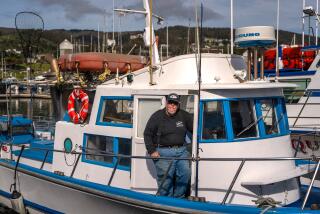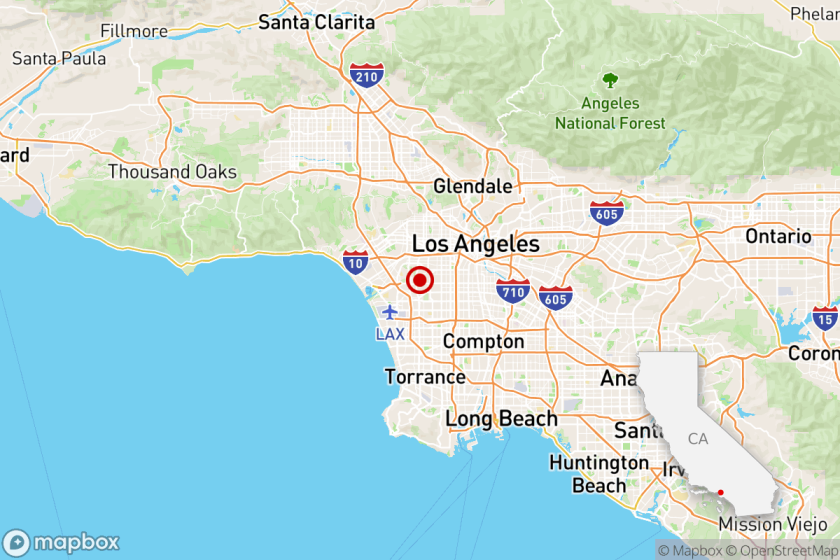Alaskan economy faces a fork in the river

Fly overhead in a bush plane -- there are no roads between native villages -- and marvel: Eight giant rivers braid across hundreds of miles of wetlands, carving cobalt ribbons through snow-coned mountains before emptying into Bristol Bay.
For more than a century, the wealth of this southwest Alaska watershed has sprung from the astonishing volume of salmon nurtured by those wild rivers. Bank-to-bank, gill-to-gill, tens of millions of silver-hued fish thrash upstream to spawn each year, unrestrained by dams, untainted by pollution.
FOR THE RECORD:
Alaska mining: A map accompanying an article on Alaska mining in Saturday’s Section A labeled three administrative areas in the state as counties. Two of them, Kenai Peninsula and Lake and Peninsula, are boroughs; Dillingham is a census area. —
It is the largest sockeye run in the world, accounting for more than a quarter of wild salmon harvested in the United States, feeding millions at a time when fisheries are dwindling across the globe.
But if fish have made the region’s past and present fortune, the future sparkles with the promise of precious metal. Beneath the rolling tundra, straddling the headwaters of two of the watershed’s most productive rivers, a Canadian company has discovered North America’s biggest deposits of gold and copper, worth about $300 billion in today’s soaring commodities markets.
The dilemma is whether Alaskans will have to choose between the two -- and whether the watershed, its fish and a host of other wildlife will be casualties of what could probably be one of the world’s biggest mines. The project would entail five earthen dams, of which two would be bigger than China’s Three Gorges Dam.
Fueled by daily pro and con advertising on Alaska television, the debate is engaging state and federal politicians, commercial fishermen, Eskimo and Indian villages, the international sportfishing community, environmental groups, major foundations and multinational conglomerates in a state that rarely turns down a major mine permit.
Northern Dynasty Minerals Ltd. of Vancouver, Canada, and partly owned by London-based Rio Tinto, has already drilled hundreds of exploratory holes, some more than a mile deep, on state-owned land in what’s known as the Pebble claim. London-based Anglo American, one of the world’s largest mining companies, announced this summer that it would spend $1.4 billion for a 50% partnership to mine the metal.
Opponents say a proposed Pebble mine would destroy one of the planet’s last sustainable fisheries, dry up spawning streams, and poison lakes and groundwater with acid runoff. Biologists have found that salmon’s genetic radar, which enable the fish to return from the bay to the very streams where they were spawned, can be ruined by microscopic particles of copper dust.
And Bristol Bay’s other wildlife -- including one of the world’s largest brown bear populations, a 45,000-head Mulchatna caribou herd, moose, wolverines, beavers and eagles -- also depends on clean water.
Northern Dynasty officials scoff at what they call an alarmist campaign. “We know Bristol Bay is a sensitive area,” said Sean Magee, vice president for public affairs. “But there’ve been tremendous changes in the mining industry in the past 25 years. These projects can be done safely now: Mining and fishing can coexist.”
What is clear is that the mine -- wedged between Lake Clark and Katmai national parks -- would entail a staggering scale of industrialization.
If the full resource were developed, as much as 12 billion tons of earth would be excavated and milled to extract the tiny flecks of metal: about 82 million ounces of gold, 67 billion pounds of copper and 4 billion pounds of molybdenum.
Ten square miles of impoundments would fill two valleys, to store in perpetuity more than 2.5 billion tons of waste rock and toxic residue.
And to transport equipment and ore, a new 104-mile road would cut through undeveloped forest and wetlands, skirting Lake Iliamna, Alaska’s largest body of fresh water. The lake is host to rare freshwater seals and is a primary spawning bed for sockeye, the red-fleshed salmon that are among the world’s most prized eating fish.
And Pebble may be just the beginning.
Northern Dynasty’s exploration has sparked a surge of claim-staking, with eight other companies asserting rights over more than 700 square miles nearby.This month, the U.S. Bureau of Land Management will make a final decision on whether to allow hard-rock drilling on 3,300 square miles of federal land in the area.
“A massive mining district would carve the heart out of the watershed,” said Richard Jameson, president of the Renewable Resources Coalition, a statewide anti-Pebble group, which is backing legislation and ballot measures to stop the mine.
Northern Dynasty’s environmental studies won’t be ready until 2009, and obtaining the 67 required state and federal permits could take three more years. But already, Magee said, “Debate is at fever pitch.”
Opponents are waging an uphill struggle. Because Pebble is on state land, the key decisions will come from the Alaska Department of Natural Resources whose commissioner, Tom Irwin, is a former mining executive and whose mission is to promote development.
“It’s the fox guarding the chicken coop,” said Norman Van Vactor, Bristol Bay manager for Peter Pan Seafoods, which operates the area’s oldest cannery.
In the state capital this year, Northern Dynasty lobbyists beat back legislation that would have created a game refuge overlapping the mine site and would have barred polluting or diverting water from salmon streams. But the bills will be revived next year.
So far, Republican Gov. Sarah Palin has remained neutral. She has fished in Bristol Bay herself, and her husband fishes commercially. They named one of their daughters Bristol.
The outcome may hinge less on environmental values than on which economic resource Alaskans value most.
“You can’t eat gold,” says Robin Samuelsen, a commercial fisherman and chief of the Curyung Tribal Council in Dillingham, the region’s principal town.
Bristol Bay’s fishery, with $450 million in annual economic benefits, employs 10,000 people in seasonal jobs, including 6,800 fishermen. And it could grow in value: Because contaminants in farmed seafood have come to light, consumers are increasingly turning to wild salmon for health benefits and its superior taste.
This time of year, the rivers that feed Bristol Bay are bedecked with racks of drying salmon, ready to be stored for the winter. In an area where imported food is prohibitively expensive, several thousand Athabaskan Indians and Yupik Eskimos depend on fish, moose, caribou, wild greens and berries.
“I’d rather eat porcupine than hamburger,” says Jack Hobson, tribal council president of Nondalton, the village closest to the proposed mine. An Athabaskan outpost of about 220 residents, with its homes of weathered clapboard and corrugated steel, scattered along a dirt road, is plastered with anti-Pebble signs.
Hobson has been a vocal opponent of the mine since the Renewable Resources Coalition flew him and other native leaders to see mines in Nevada. There, he said, they saw landscape that looked like it had been “bombed” -- huge pits, contaminated water and depleted aquifers that have forced a local Indian tribe to truck in drinking water.
Northern Dynasty’s helicopters, he said, have scared away caribou for the last two years, depriving villagers of a diet staple. Once the mine is built, he added, “dust will blow all over the plants and the animals will eat this stuff, and -- oh boy!”
The region’s 50 commercial lodges are also threatened. The international sportfishing mecca attracts anglers who pay as much as $8,000 a week to fly in and cast for rainbow trout that measure up to 3 feet.
But mining would mean high-paying, steady jobs at a time when fish prices remain volatile and the North Slope oil that has buoyed the economy is dwindling.
Pebble would run for 50 to 80 years, said Bruce Jenkins, Northern Dynasty’s chief operating officer, and “go a long way toward eradicating poverty in southwest Alaska forever.”
In the last two years, Northern Dynasty has mounted a massive public relations campaign, helicoptering in nearly 1,000 politicians, business leaders, teachers and other influential Alaskans to the site.
The company has staged 800 presentations, in remote villages as well as in Anchorage, offering residents expense-paid trips. Tribal leaders have been hired as “community outreach people,” and more than 120 local residents are on Northern Dynasty’s payroll as $17-an-hour drill assistants, bear guards and other mine-related jobs.
Opponents accuse the company of buying influence, but Magee replies: “We don’t apologize for hiring local people.”
And opponents also have deep-pocket patrons, including Anchorage investor Robert B. Gillam, head of McKinley Capital Management Inc., who has a private lodge 24 miles from the Pebble claim. The foundation of another wealthy angler, Intel Corp. pioneer Gordon Moore, has awarded $5 million to local conservationists, including Earthworks, a Washington-based group organizing jewelers to boycott Pebble gold.
In Newhalen, a village of 120 on a windy promontory above Lake Iliamna, Ray Wassillie, the local tribal chief, has a part-time job as a fish observer, and his three sons are also employed by Northern Dynasty.
“No one else is offering our kids the opportunity to work,” said Wassillie. Fewer young people in the village “are going to jail when they’re doing nothing. Drugs and alcohol become a big part of life,” he said.
Home heating fuel costs Wassillie $6,000 yearly, and gas to run his four-wheelers for subsistence hunting runs more than $5 a gallon. The bay’s six-week fishing season “doesn’t generate enough income for my living standards,” he said.
Beyond the local economy, Northern Dynasty says, the mine will bring benefits to the nation. While critics say that gold -- 75% of which is used in jewelry -- is an unnecessary luxury, the company says the copper to be produced by the mine is “a strategic metal.” U.S. copper imports are growing as voracious economies in China and India compete for metal.
But environmentalists, citing the web of interconnected streams, ponds and groundwater, say the risk is unacceptable. Salmon is the region’s keystone species, food for bears, eagles -- and people. And as the fish decompose after spawning, their carcasses fertilize plants that nourish caribou and other wildlife.
Despite a rash of negative publicity, the company declines to rule out the use of cyanide, a toxin that helps extract metal from ore and has contaminated watersheds throughout the West.
The region is one of the most earthquake-prone areas on the globe, but Northern Dynasty counters that its dams would be engineered to withstand a 7.8-level quake.
“Most Americans will never get to Bristol Bay,” said Brian Kraft, who owns a local fishing lodge and works for the conservation group Trout Unlimited. “But they see our bears playing in waterfalls on the Discovery Channel. They can experience the taste of wild salmon.
“They know that we can destroy places like this, but we can’t create them.”
margot.roosevelt@latimes.com
More to Read
Start your day right
Sign up for Essential California for news, features and recommendations from the L.A. Times and beyond in your inbox six days a week.
You may occasionally receive promotional content from the Los Angeles Times.







